The Twin
Pillars of Victory
In May of 1862 St. John Bosco
had a prophetic dream about the Church in these times: the battle and the
victory. St. John Bosco had a great affection for Our Lady. His whole life
was spent working for the glory of God and the salvation of souls with the
aid of the Blessed Mother, whom he addressed as Mary Help of Christians.
He had an unusual charism of the Holy Spirit and that was the gift of
prophetic dreams. The following is the prophetic dream of May, 1862 taken
from a book, entitled Forty Dreams of St. John Bosco, compiled by
Fr. J. Bacchiarello, S.D.B.
St. John
Bosco Describes His Dream

"Imagine yourselves to
be with me on the seashore, or better, on an isolated rock and not to see
any patch of land other than what is under your feet. On the whole of that
vast sheet of water you see an innumerable fleet of ships in battle array.
The prows of the ships are formed into sharp, spearlike points so that
wherever they are thrust they pierce and completely destroy. These ships
are armed with cannons, with lots of rifles, with incendiary materials,
with other arms of all kinds, and also with books, and they advance
against a ship very much bigger and higher than themselves and try to dash
against it with the prows or to burn it or in some way to do it every
possible harm.
"As escorts to that
majestic fully equipped ship (the Church), there are many smaller ships,
which receive commands by signal from it and carry out movements to defend
themselves from the opposing fleet.
"In the midst of the
immense expanse of sea, two mighty columns of great height arise a little
distance the one from the other. On the top of one, there is the statue of
the Immaculate Virgin, from whose feet hangs a large placard with this
inscription: Auxilium Christianorum - 'Help of
Christians'; on the other, which is much higher and bigger, stands
a Host of great size proportionate to the column and beneath is another
placard with the words: Salus Credentium - 'Salvation
of the Faithful.'
"The supreme commander
on the big ship is the Sovereign Pontiff. He, on seeing the fury of the
enemies and the evils among which his faithful find themselves, determines
to summon around himself the captains of the smaller ships to hold a
council and decide on what is to be done.
"All the captains come
aboard and gather around the Pope. They hold a meeting (probably the First
Vatican Council: 1869-1870), but meanwhile the wind and the waves gather
in storm, so they are sent back to control their own ships. There comes a
short lull; for a second time the Pope gathers the captains together
around him (probably the Second Vatican Council: 1962-1965), while the
flagship goes on its course. But the frightful storm returns. The Pope
stands at the helm and all his energies are directed to steering the ship
towards those two columns, from the top of which and from every side of
which are hanging numerous anchors and big hooks, fastened to chains.
"All the enemy ships
move to attack it, and they try in every way to stop it and to sink it:
some with writings or books or inflammable materials, of which they are
full; others with guns, with rifles and with rams. The battle rages ever
more relentlessly. The enemy prows thrust violently, but their efforts and
impact prove useless. They make attempts in vain and waste all their labor
and ammunition; the big ship goes safely and smoothly on its way.
Sometimes it happens that, struck by formidable blows, it gets large, deep
gaps in its sides; but no sooner is the harm done than a gentle breeze
blows from the two columns and the cracks close up and the gaps are
stopped immediately.
"Meanwhile, the guns of
the assailants are blown up, the rifles and other arms and prows are
broken; many ships are shattered and sink into the sea. Then, the frenzied
enemies strive to fight hand to hand, with fists, with blows, with
blasphemy and with curses.
"All at once the Pope
falls gravely wounded. Immediately, those who are with him run to help him
and they lift him up. A second time the Pope is struck, he falls again and
dies. A shout of victory and of joy rings out amongst the enemies; from
their ships an unspeakable mockery arises. (Possibly refers to Pope John
Paul I who was deeply devoted to Fatima and died under suspicious
circumstances.)
"But hardly is the
Pontiff dead than another Pope takes his place. The pilots, having met
together, have elected the Pope so promptly that the news of the death of
the Pope coincides with the news of the election of the successor. The
adversaries begin to lose courage.
"The new Pope, putting
the enemy to rout and overcoming every obstacle, guides the ship right up
to the two columns and comes to rest between them; he makes it fast with a
light chain that hangs from the bow to an anchor of the column on which
stands the Host; and with another light chain which hangs from the stern,
he fastens it at the opposite end to another anchor hanging from the
column on which stands the Immaculate Virgin.
"Then a great convulsion
takes place. All the ships that until then had fought against the Pope' s
ship are scattered; they flee away, collide and break to pieces one
against another. Some sink and try to sink others. Several small ships
that had fought gallantly for the Pope race to be the first to bind
themselves to those two columns.
"Many other ships,
having retreated through fear of the battle, cautiously watch from far
away; the wrecks of the broken ships having been scattered in the
whirlpools of the sea, they in their turn sail in good earnest to those
two columns, and, having reached them, they make themselves fast to the
hooks hanging down from them and there they remain safe, together with the
principal ship, on which is the Pope. Over the sea there reigns a great
calm."
St. John Bosco explains his
dream: "The enemy ships are persecutions. The most serious trials for
the Church are near at hand...Her enemies are represented by the ships
that tried to sink the ship if they could. Only two means are left to save
her amidst so much confusion: DEVOTION TO MARY MOST HOLY and FREQUENT
COMMUNION, making use of every means and doing our best to practice them
and having them practiced everywhere and by everybody."

St John Bosco's dream
|